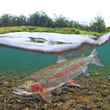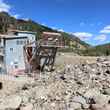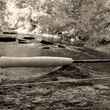Over the last 20 years, the federal government has invested nearly $17 billion into the recovery of Snake River Basin salmon and steelhead. Today, all stocks of salmon and steelhead in the basin are gravely imperiled and some are at the precipice of extinction.
Whether it’s trucking or barging fish around dams or culling predators, there’s very little evidence of any success where recovery is concerned. Unless major new actions are agreed upon and adopted by the many stakeholders along the lower Snake River, the prized B-run steelhead and the runs of massive chinook salmon that run up the Columbia, into the Snake and eventually into their natal streams in Idaho and northeast Oregon will simply go away.
“Whether or not we have these fish in a couple of decades depends on the decisions we make today,” said Rob Masonis, vice president for western conservation for Trout Unlimited.
And those decisions will have to include the removal of four lower Snake River dams—the final four of eight total dams salmon and steelhead of rivers like the Grand Ronde in Oregon, or the Clearwater and the Salmon in Idaho must traverse. And they must traverse them twice—once on the way to the Pacific as smolts and then again on the way home as adults to build redds and spawn in the wild headwaters of the drainage.
“There are no alternatives short of dam removal that would recover Snake River Basin salmon and steelhead,” Masonis told a group of TU volunteers, power industry leaders, biologists and anglers during a conference call earlier this week.
“We need to take these dams out on the lower Snake River.”
The four dams — Ice Harbor, Lower Monumental, Little Goose and Lower Granite — were constructed and brought online for power generation, irrigation, flood control and barge commerce between 1962 and 1975. Historically, before the dams came online, about 2 million ocean-going trout and salmon migrated up the Snake River every year. Last year, only 40,000 salmon and 35,000 steelhead passed Lower Granite Dam, the highest of the four dams on the lower Snake.
“It’s a question of whether or not we’re going to be able to avoid extinction, let alone recover [Snake River salmon and steelhead] if we don’t change the status quo,” Masonis said.
And the time for changing the status quo might be right now. As Masonis pointed out, there’s a convergence of events taking place that could very literally put dam removal on the table.
First, U.S. Rep. Mike Simpson, a Republican from Idaho, spoke at an Andrus Center for Public Policy event in Boise last spring, where he was quoted as saying, “I am going to stay alive long enough to see salmon return to healthy populations in Idaho.”
At the time, the statement sent shockwaves through the political and environmental communities in the Northwest. Chris Wood, president and CEO of Trout Unlimited took immediate note of Simpson’s statement.
“This is the first time in 15 or 20 years, because of his leadership, that I feel positive that we can finally begin to sit down with these communities of interest that want to maintain the status quo and those of us want to see healthy, abundant, fishable populations of salmon back, and come to an accord where nobody is left behind,” Wood said.
Couple Simpson’s statement with news that the southern orca population that swims off the coast of Washington is, like the salmon and steelhead, on the brink of extinction. These charismatic whales depend heavily on the chinook salmon that run out of the Columbia River and swim as far north as Alaska. Unless more salmon can be added to the system, these cherished and high-profile animals are in real trouble.
Also, large amounts of wind and solar power are coming online, and financial pressure on the Bonneville Power Administration (which markets power generated by dams on the Snake and Columbia) gives stakeholders reason to believe dam breaching can be given serious consideration.
The dams
While there are eight dams that Snake River basin salmon and steelhead must traverse both to and from the ocean, the four lower Snake dams have proven to be four too many — once Lower Granite came online in 1975, the numbers really tanked and have never approached pre-dam levels since. In fact, since the runs were listed as threatened under the Endangered Species Act in the 1990s, neither salmon nor steelhead in the Snake River basin have approached the minimum abundance necessary to sustain current depressed populations.
Yes, each of the four dams is equipped with fish passage, but passage “at the concrete” is just one part of a much larger problem. When someone looks at any of the four dams on the lower Snake, “what you don’t see is a river,” Masonis said. Instead, what people see is a series of slackwater reservoirs—140 miles of slow-moving water— that, by themselves, take a heavy toll on migrating salmon and steelhead.
First, the dams slow and warm the river, which changes the foundational food web of the system. Where water used to rush through the channel carved by the Snake eons ago, it now meanders slowly 140 miles, often heating up beyond tolerance levels for both outgoing smolts and returning adults. The “river” is now excellent habitat for non-native predators like walleye and smallmouth bass, as well as voracious birds that find it much easier to kill out-migrating salmon and steelhead young. The dams also slow outmigration of both salmon and steelhead dramatically, and the small fish have to actively swim downstream, not just ride the current and save energy like they did when the river was free-flowing. A journey by young smolts that used to take two days from their natal streams to the ocean now takes in excess of 20 days.

“[The dams] fundamentally change the ecology of the system,” Masonis said.
Regardless of what the lower Snake River dams have done to the salmon and steelhead runs that have persisted in the drainage for millions of years, there’s no argument that the dams provide benefits to the regional economy. The dams provide inexpensive, reliable power and have enabled commodity shipments by river barge to downstream ports. Today, alternative means of providing those benefits exist. In fact, a 2018 study demonstrated that power generated by the lower Snake River dams could be replaced with inexpensive, efficient solar and wind power using currently available technology.
What does not exist, Masonis said, is an alternative to removing the four lower Snake River dams that will enable salmon and steelhead to recover.
The fish
Salmon and steelhead in the Pacific Northwest have persisted for eons and are remarkably resilient. Smolts in the Snake River basin swim as far as 900 miles to the sea. Returning adults not only must pass over eight dams, but they climb several thousand feet in elevation from the Pacific to their natal spawning streams high in the mountains of Idaho and Oregon. They’ve survived everything from the geologic reorganization of rivers to multiple glacial incursions and retreats to volcanic eruptions, floods, fires and ever-changing conditions in the ocean.
“Not only have they persisted in this dynamic environment,” said Dr. Helen Neville, TU’s senior scientist, “but it is this environment that has shaped their diversity and their resiliency.”
That they now stand on the edge of extinction is a testament to the destructive power of the lower Snake River dams.
Snake River basin salmon and steelhead have evolved over millennia to protect their populations against the worst possible outcome—complete devastation of their spawning runs. Some steelhead begin their homeward migrations in the summer. Others wait until fall or even early winter. Likewise, some salmon migrate in late summer while others wait until fall. And, salmon and steelhead use different habitats in the Snake basin. Some migrate to the Clearwater River system in Idaho, others to the Salmon River and still others to the Grand Ronde in Oregon. This prevents all of a given year’s migrating fish from being in the same place at the same time, protecting them from impacts that might otherwise threaten the entire spawning population.
Neville calls this evolutionary phenomenon the “portfolio effect.”
“None of us would invest all our money in one asset, like a stock,” she explained. “We diversify our assets into mutual funds and bonds … because we know that decreases the volatility and the risk of our investments. It’s the same with salmon and steelhead in that a diverse biological portfolio provides stability by increasing their resistance and resilience to ecosystem change and environmental change.”
Historically, half of the salmon returning to the larger Columbia River system were harvested. But, as the lower dams on the Columbia started to come online, the returns began to dwindle. Finally, as the dams on the Snake were constructed, fisheries managers were forced to curtail the commercial and recreational harvest because fish numbers had fallen so precipitously.

The numbers have never again approached pre-dam abundance. As Neville put it, “We’ve been bouncing around these very low numbers ever since the Snake River dams were completed.”
Before the lower Snake dams were completed, about 120,000 wild chinook salmon would make it to their spawning waters. Since, salmon numbers have generally been below 10,000 and, in a good year with restricted harvest, might approach 30,000.
In the 1990s, participants from 15 state and federal agencies, tribes and hired consultants conducted the Plan for Analyzing and Testing Hypotheses (PATH). This effort concluded that restoring the lower Snake River to a complete river ecosystem (by removing the four dams) was the recovery option that offered the best chance for salmon and steelhead recovery and offered the least amount of risk. The conclusions of PATH have been reaffirmed by scientific review panels, agencies and the science community ever since.
A second analysis—the Comparative Survival Study—conducted by tribes and a host of agencies, including the U.S. Fish and Wildlife Service and Idaho Fish and Game, used PIT tags to monitor fish as they moved through the hydrosystem. The study determined that, in order to simply persist and avoid extinction, for every group of out-migrating salmon or steelhead smolts, 2 percent need to return as adults to spawn; rebuilding robust, harvestable stocks requires an average of 4 percent. Between 2006 and 2015, that number for Snake River basin steelhead averaged 1.8 percent.
Those opposed to removal of the lower Snake River dams have suggested that the problem can be solved by simply adding more hatchery fish to the system.
Hatcheries may be a necessary part of the path forward. But “the problem with hatchery fish is that it’s impossible to maintain those diverse life histories and local adaptations of the portfolio effect in a hatchery environment,” Neville said. “Hatchery fish have lower fitness than wild fish, and when hatchery fish interbreed with wild fish, it can really erode the fitness of these wild populations.”
A 2016 study found that the offspring of wild and hatchery fish differed in the activity of more than 700 genes — in just a single generation of hatchery rearing.
And, there are currently 28 million hatchery salmon and steelhead released throughout the system every year. If hatchery fish were the solution, that would have become evident by now.
The habitat
The Snake River basin—specifically the roadless heart of Idaho that encompasses river drainages like the Middle Fork of the Salmon River—offers perhaps the best inland salmon and steelhead spawning and rearing habitat left in the Columbia River system. This high-elevation spawning habitat also offers a coldwater refuge for salmon, something that will become more important as the impacts of climate change continue to mount.
In 2008, the state of Idaho, with the help of a collaborative team of stakeholders, crafted its very own roadless rule—in many instances, the Idaho rule is more protective of backcountry resources than the 2001 national Roadless Rule. Idaho’s roadless lands include the Frank Church River of No Return Wilderness, which encompasses the Middle Fork of the Salmon River. It’s no coincidence that this region is Idaho’s most productive when it comes to spawning and rearing salmon and steelhead. In total, Idaho has almost 9 million acres of intact roadless land—the bulk of it encompasses potential salmon and steelhead habitat.
“There certainly are places, like in the Lemhi or Yankee Fork systems, where habitat restoration is helpful and large partnerships are working on habitat restoration in those basins. But the Middle Fork is a really good example of why habitat is not the issue in much of the Snake,” Neville said. “The fish in the Middle Fork are in intact, complex habitat. There’s very little harvest, and there are no hatcheries in that system.”
So, Neville said, if habitat were the issue there, the Middle Fork should be home to some of the most robust salmon and steelhead populations anywhere in the lower 48. Unfortunately, that’s not the case. Salmon redd counts in the Middle Fork virtually mirror the declines recorded throughout the Snake basin, regardless of habitat quality.
“In fact,” Neville continued, “The Middle Fork has been documented to have some of the highest production values recorded for spring/summer chinook salmon. It’s a very robust population in terms of its ability to produce fish out of the system. The fish simply aren’t getting back to maintain the population.”
The message? Even with the aggressive restoration work underway across much of the Snake River basin to repair damage done to spawning habitat over the last 130 years, the fish have to be able to get back to that improved habitat to make a difference. The onus for the vast majority of salmon and steelhead decline lies on the four dams on the lower Snake River that impede fish both on their way to the Pacific and again on their way home.
The solution
According to Masonis, who has been a part of the salmon and steelhead recovery effort in the Northwest for two decades, the science very clearly reveals the steps necessary to recover Snake River basin salmon and steelhead.
“We need to take the dams out on the lower Snake River, and at least get that part of the migratory corridor and river system free-flowing again in order to have a chance at meeting the goals of a healthy, harvestable and fishable population of naturally produced fish,” he said.
Masonis said no other alternatives exist that have a realistic shot at restoration and recovery success.
“TU has always taken the position that if there are those actions out there, we would love to know about them,” he said. But, in 20 years, no such proposals have been able to stand up to the science.
And, he said, it’s likely not going to take just removing the four dams on the lower Snake. Other efforts will need to be taken, too, like continued habitat restoration in the basin and smart management of the four lower Columbia River dams. He also said predator control and hatchery reforms might also be a part of the overall recovery equation—it would all be part of a “collective suite of actions” to boost Snake River basin salmon and steelhead. Restoring a free-flowing lower Snake River is the cornerstone on which other those other actions must be layered.
“They are remarkable creatures that can respond to adversity in incredible ways,” Neville said. “Their evolutionary history demonstrates their ability to recover if we give them the chance to get back to their habitat.”
An earlier version of this article indicated that 20,000 steelhead passed Lower Granite Dam in 2019.

































Comments